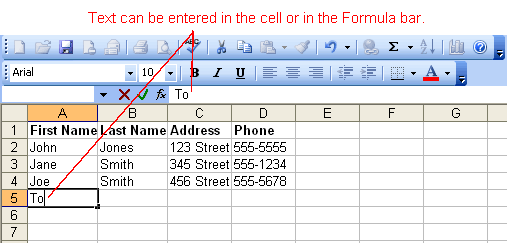Mastering Data Manipulation: A Comprehensive Guide to Entering, Editing, and Deleting Data in Microsoft Excel 2003

Introduction:
Microsoft Excel 2003, a venerable spreadsheet application, has been a stalwart companion for users seeking to organize and analyze data. The ability to enter, edit, and delete data lies at the core of Excel’s functionality, forming the bedrock for effective data manipulation. In this extensive guide, we will navigate through the intricacies of these fundamental operations, providing users with an in-depth understanding of Excel 2003’s capabilities for managing and refining their data.
Section 1: The Canvas of Excel
1.1 The Digital Canvas: Excel’s interface serves as a digital canvas where data comes to life. Delve into the concept of cells, rows, and columns, understanding their role in creating a structured grid that facilitates the entry and manipulation of data.
1.2 Navigating the Worksheet: Excel 2003’s worksheet is the primary space where data is entered and organized. Explore the essentials of navigating the worksheet, understanding the grid system, and becoming familiar with the layout that forms the foundation for data manipulation.
Section 2: Entering Data
2.1 Basic Data Entry: The process of entering data in Excel is a foundational skill. Uncover the nuances of basic data entry, learning how to input text, numbers, and dates into cells. Explore the various data types and their representations within Excel.
2.2 Formatting Cells: Beyond basic entry, formatting cells is crucial for enhancing the presentation and interpretation of data. Delve into cell formatting options, including adjusting font styles, sizes, and cell alignment, to customize the appearance of your data.
Section 3: Advanced Data Entry Techniques
3.1 AutoFill and Flash Fill: Excel 2003 introduces time-saving features like AutoFill and Flash Fill. Learn how to use AutoFill to extend series and patterns in your data efficiently. Explore the more advanced Flash Fill, which automates the extraction and transformation of data based on patterns.
3.2 Data Validation: Ensure data accuracy by implementing data validation. Understand how to create rules and restrictions, preventing the entry of invalid data and promoting consistency in your datasets.
Section 4: Editing Data
4.1 Cell Editing: Editing data within cells is a fundamental aspect of data refinement. Explore the various methods for cell editing, including simple text edits, numerical adjustments, and date modifications. Master the art of navigating within cells for precise edits.
4.2 Find and Replace: Excel’s Find and Replace functionality is a powerful tool for efficient data editing. Discover how to locate specific data within your workbook and replace it with new values, streamlining the editing process for large datasets.
Section 5: Deleting Data
5.1 Deleting Cells, Rows, and Columns: Deleting data is a necessary part of data management. Learn how to delete individual cells, entire rows, and columns, understanding the implications of these actions on the overall structure of your worksheet.
5.2 Clearing and Undoing Actions: Delve into techniques for clearing data from cells without removing the cell itself. Explore the Undo feature, a valuable tool for reverting changes and restoring the previous state of your workbook.
Section 6: Handling Errors and Auditing
6.1 Error Checking: Excel 2003 provides built-in error checking features to identify and rectify potential issues in your data. Explore how to use error checking to detect common errors such as formula inconsistencies and inconsistent data types.
6.2 Auditing Tools: Understand the auditing tools in Excel 2003, such as tracing precedents and dependents. These tools help users track the relationships between cells and formulas, ensuring the accuracy and integrity of complex datasets.
Section 7: Protecting and Securing Data
7.1 Cell Protection: Safeguard your data by exploring cell protection options in Excel. Learn how to lock and unlock cells, providing control over which cells can be edited and ensuring the integrity of critical data.
7.2 Password Protection: Excel 2003 allows users to password-protect workbooks, preventing unauthorized access and modifications. Delve into the process of securing your data with password protection, balancing security needs with convenient access.
Section 8: Data Sorting and Filtering
8.1 Sorting Data: Excel 2003 offers powerful sorting capabilities to organize data based on specific criteria. Explore the sorting options, both in ascending and descending order, to arrange your data systematically.
8.2 Filtering Data: Understand how to employ filters to focus on specific subsets of your data. Excel’s filtering options allow users to display only the information relevant to their analysis, enhancing the efficiency of data exploration.
Conclusion:
In conclusion, mastering the art of entering, editing, and deleting data in Excel 2003 is pivotal for effective data manipulation. This comprehensive guide equips users with the skills to navigate Excel’s digital canvas, enter data with precision, and refine datasets through advanced techniques. By understanding the nuances of editing and deleting data, users can ensure data accuracy and maintain the integrity of their spreadsheets. As Excel 2003 continues to stand the test of time, its robust features for data manipulation empower users to transform raw information into insightful analyses, fostering efficiency and proficiency in the realm of spreadsheet software.







